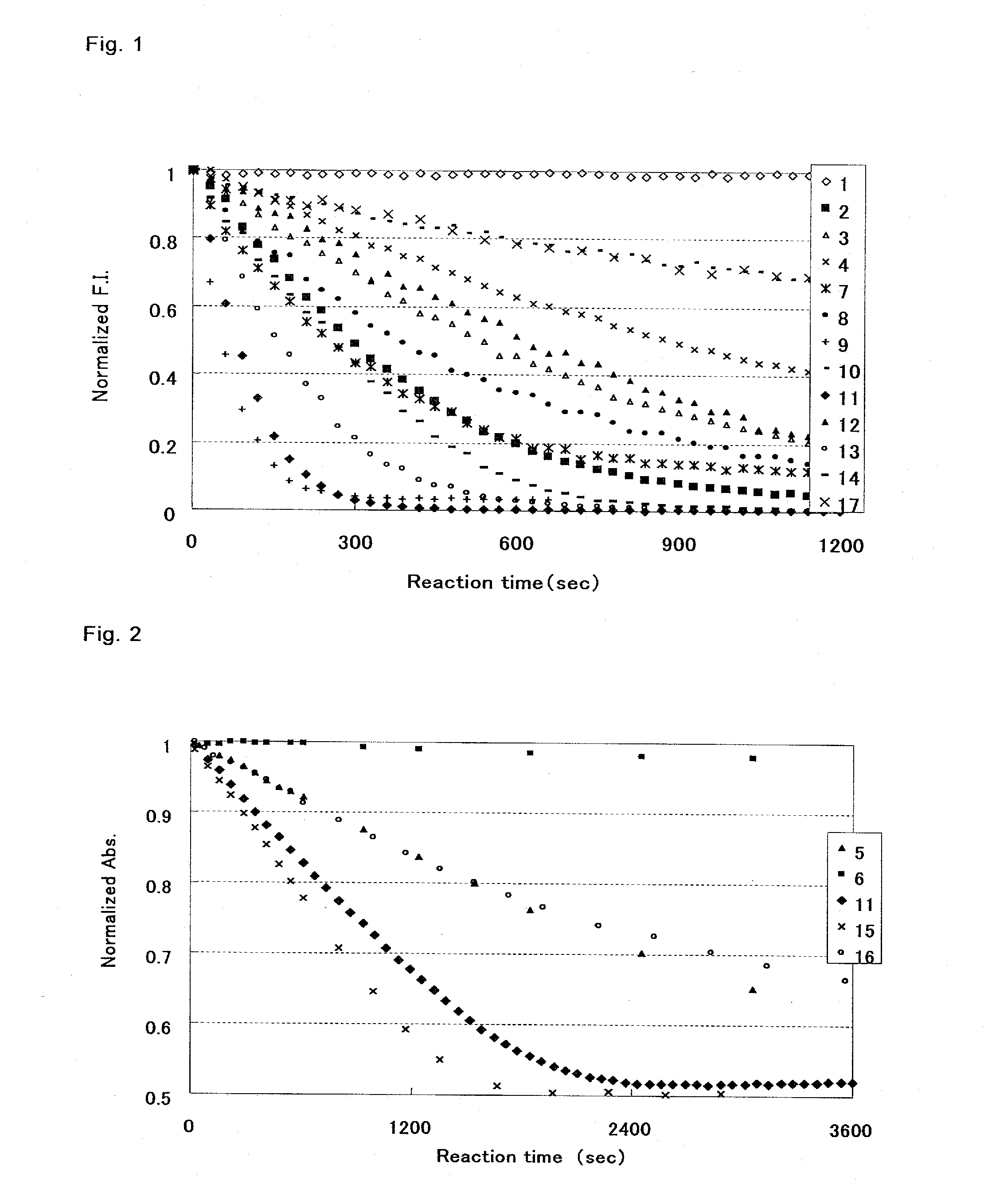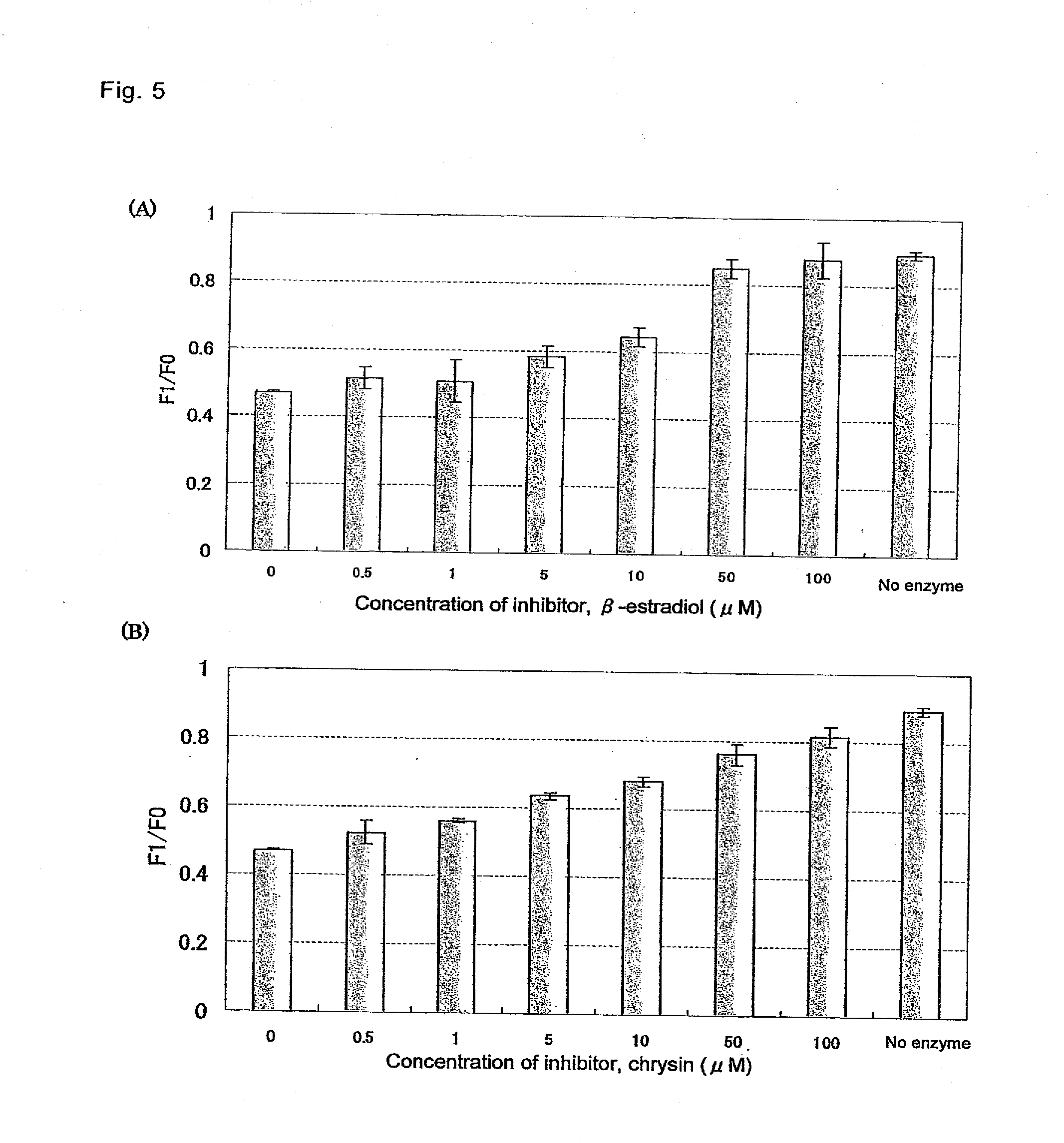Fluorescent probe for measurement of glucuronate transferase
a technology of glucuronate transferase and fluorescent probe, which is applied in the field of can solve the problem of inability to use fluorescein as a fluorescent probe for measuring udpglucuronosyltransferase activity, and achieve the effect of high-sensitivity measurement of udpglucuronosyltransferase activity
- Summary
- Abstract
- Description
- Claims
- Application Information
AI Technical Summary
Benefits of technology
Problems solved by technology
Method used
Image
Examples
example 1
[0034]According to the following protocols, fluorescein (Compound 1), fluorescein derivatives in which the 2-carboxy group on the benzene ring of fluorescein was replaced with another substituent (Derivatives 2 to 16), and a conventional compound having the coumarin structure, scopoletin (Compound 17) were examined for reactivity with UGT1A1.
[0035]A solution of the following composition was prepared in a 3000 μL cuvette (total volume: 3000 μL)
Probe: fluorescein derivative (1 μM or 10 μM)
MgCl2 (8 mM)
[0036]Alamethicin (0.025 mg / mL)
UDP-glucuronic acid (2 mM)
Adjusted to a total volume of 2940 μL with 0.1 M Tris-HCl buffer (pH 7.5)
↓
Addition of 60 μL of UGT1A1 microsome solution (5.0 mg / mL, final concentration: 0.1 mg / mL)
↓
Fluorescence or absorbance measurement with stirring or pipetting (37° C.)
[0037]In this example, when a fluorescent compound was used as a substrate, 1 μM solution of a fluorescein derivative was used, and fluorescence measurement was performed by irradiating an excitati...
example 2
[0040]According to the following protocols, fluorescein derivatives in which methoxy group or chlorine atom was introduced at the 2-position and / or the 7-position of fluorescein (the compounds described in (A), (B), and (C) mentioned below) were examined for reactivity with UGT1A1. The results are shown in FIG. 3. As seen in FIG. 3, (C), a tendency was observed that a decrease rate of fluorescence of fluorescein methyl ester (Derivative 4) was reduced by the introduction of chlorine atom, whilst it was confirmed that a decrease rate of fluorescence was increased by the introduction of methoxy group. The same results were also obtained when methoxy group was introduced into 2-MeTG (Derivative 2) as seen in FIG. 3, (B).
[0041]A solution of the following composition was prepared in a 3000 μL cuvette (total volume: 3000 μL)
Probe: the compound described in (A), (B), or (C) mentioned below (1 μM)
MgCl2 (8 mM)
[0042]Alamethicin (0.025 mg / mL)
UDP-glucuronic acid (2 mM)
Adjusted to a total volume...
example 3
[0043]The fluorescein derivatives of fluorescence decreasing type, of which fluorescence is decreased by a reaction with UGT, were obtained in Examples 1 and 2. Further researches were conducted in order to provide fluorescein derivatives of fluorescence increasing type of which fluorescence is increased by a reaction with UGT. Functionally, the structure of fluorescein can be recognized as two parts having different functions, i.e. the benzene ring moiety and the xanthene ring moiety. By appropriately choosing substituents on the benzene ring moiety among them, fluorescence thereof can be controlled by using PeT (J. Am. Chem. Soc., 123, pp. 2530-2536, 2001). On the other hand, it is known that the electron donating ability of the xanthene ring moiety is decreased by conversion of the phenolic hydroxy group of the moiety from phenolate type to O-glycoside type (J. Am. Chem. Soc., 127, pp. 4888-4894, 2005). Therefore, it is considered that there can be developed a fluorescence increa...
PUM
| Property | Measurement | Unit |
|---|---|---|
| absorption maximum wavelength | aaaaa | aaaaa |
| total volume | aaaaa | aaaaa |
| total volume | aaaaa | aaaaa |
Abstract
Description
Claims
Application Information
 Login to View More
Login to View More - R&D
- Intellectual Property
- Life Sciences
- Materials
- Tech Scout
- Unparalleled Data Quality
- Higher Quality Content
- 60% Fewer Hallucinations
Browse by: Latest US Patents, China's latest patents, Technical Efficacy Thesaurus, Application Domain, Technology Topic, Popular Technical Reports.
© 2025 PatSnap. All rights reserved.Legal|Privacy policy|Modern Slavery Act Transparency Statement|Sitemap|About US| Contact US: help@patsnap.com



